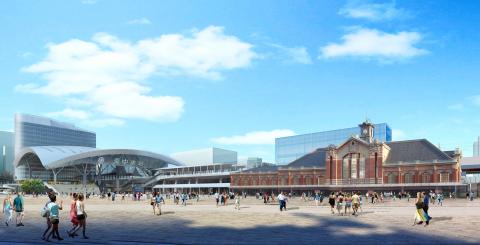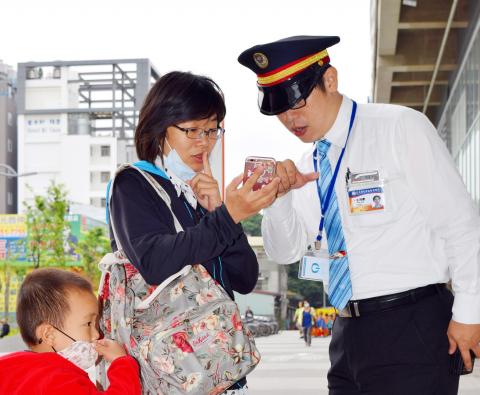Sporting his Taiwan Railways Administration cap, Taichung station director Wang He-chieh ( 王河傑 ) gets asked a lot of questions these days by Taichung commuters, with one of the most popular being, “Where are the trains?”
The confusion is short-term, railways officials hope, as travelers get accustomed to Taichung’s new NT$221 million elevated train station. Opened in October, the sleekly-designed station replaces the adjoining century-old former station.
“It’s definitely better than before,” said Li Bing-Hsing (李秉興), after arriving by train from Miaoli. “It’s not that crowed and a lot more convenient.”

Photo courtesy of Shu Chang & Associates, Architects
JAPANESE ARCHITECTURE
Preserving the past while planning for the future is what architect Shu Chang (張樞) hoped to achieve when designing the new station.
“I tried to respect the old building as much as possible,” said Chang, a Taichung native, whose company was subcontracted by CECI Engineering Consultants. “It’s one of the better examples of Japanese-era architecture.”

Photo: John Evans
To better show off the historic building, the less-sightly recent additions will be removed. The original platforms and tracks, however, will remain as part of a new railway museum that will be completed soon.
The new station’s second-floor concourse was designed to be “open air” to take advantage of Taichung’s usually mild weather, said Chang, who also teaches architecture at National Taiwan University.
A large pedestrian area on the first floor will be a multi-use public space, he said.
Chang said the new station is intended to embrace the concept of urban design, adding, “It will totally redesign that part of the city.”
With weekday ridership at 60,000, passengers at the old station often jostled for space while waiting for their train.
And when construction is completed at the end of next year, the new station will be 33,325 square meters, more than 30 times the size of the original station.
In addition, the new station will be able to accommodate more trains with its five tracks and three platforms. Currently, there are three tracks and two platforms, the same number as at the old station.
While businesses inside the new station are yet to open, train officials said convenience stores and other shops are expected to open within the next few months.
The elevated station and the adjoining tracks will help connect the city as a whole, railway officials said. A series of street-level railroad crossings had effectively cut off portions of the city’s southern and eastern areas.
The new Taichung station is just one in a series of elevated train stations and rail lines winding its way through the city.
“I’m proud of this project,” said Wang. “We’re revitalizing this area of the city.” Railway and city officials hope the new station will help create more convenience for travelers with a boom in business opportunities.
BUSINESS OPPORTUNITIES FOR SOME
The construction of the new station has already been an economic shot in the arm for an older, working-class section of the city.
From tea stands to sandwich shops, business is flourishing adjacent to the new station.
“I’m very happy. It’s 50 percent better,” said Roy Chiu (邱富崑), manager of a nearby tea stand. The upturn in business has allowed his employees to work additional hours for bigger paychecks, he said.
And while businesses near the new station are finding an economic resurgence, on the opposite side of the tracks it’s the flip side.
Convenience stores nearby the old station have reported a drop in business by about one-third.
Jiang Ming-wei (蔣名瑋) has seen the slowdown firsthand. Jiang works at a scooter parking garage a short walk from the old station where weekday business is off only slightly, but on weekdays it has plummeted 50 percent.
OLD TRAIN STATION, NEW MUSEUM
The old train station, built during the Japanese colonial era, will be leased to a private company and turned into a train museum and exhibition space, and rebranded Taichung Railway Cultural Park.
Preserving the old building, which is a National Heritage Site, is a priority, train officials said.
“The atmosphere will be a mix of old and new,” said Sophia Lin (林于茜), a TRA spokesperson.

In the March 9 edition of the Taipei Times a piece by Ninon Godefroy ran with the headine “The quiet, gentle rhythm of Taiwan.” It started with the line “Taiwan is a small, humble place. There is no Eiffel Tower, no pyramids — no singular attraction that draws the world’s attention.” I laughed out loud at that. This was out of no disrespect for the author or the piece, which made some interesting analogies and good points about how both Din Tai Fung’s and Taiwan Semiconductor Manufacturing Co’s (TSMC, 台積電) meticulous attention to detail and quality are not quite up to

April 21 to April 27 Hsieh Er’s (謝娥) political fortunes were rising fast after she got out of jail and joined the Chinese Nationalist Party (KMT) in December 1945. Not only did she hold key positions in various committees, she was elected the only woman on the Taipei City Council and headed to Nanjing in 1946 as the sole Taiwanese female representative to the National Constituent Assembly. With the support of first lady Soong May-ling (宋美齡), she started the Taipei Women’s Association and Taiwan Provincial Women’s Association, where she

Chinese Nationalist Party (KMT) Chairman Eric Chu (朱立倫) hatched a bold plan to charge forward and seize the initiative when he held a protest in front of the Taipei City Prosecutors’ Office. Though risky, because illegal, its success would help tackle at least six problems facing both himself and the KMT. What he did not see coming was Taipei Mayor Chiang Wan-an (將萬安) tripping him up out of the gate. In spite of Chu being the most consequential and successful KMT chairman since the early 2010s — arguably saving the party from financial ruin and restoring its electoral viability —

It is one of the more remarkable facts of Taiwan history that it was never occupied or claimed by any of the numerous kingdoms of southern China — Han or otherwise — that lay just across the water from it. None of their brilliant ministers ever discovered that Taiwan was a “core interest” of the state whose annexation was “inevitable.” As Paul Kua notes in an excellent monograph laying out how the Portuguese gave Taiwan the name “Formosa,” the first Europeans to express an interest in occupying Taiwan were the Spanish. Tonio Andrade in his seminal work, How Taiwan Became Chinese,